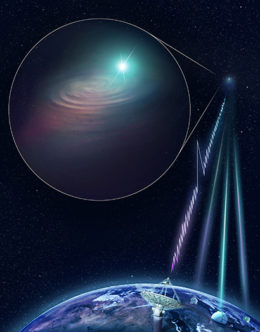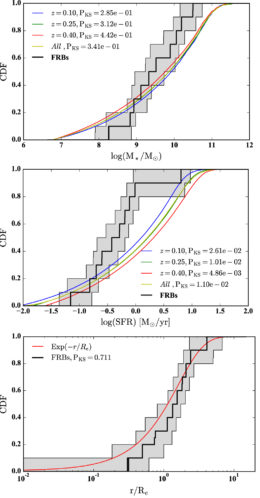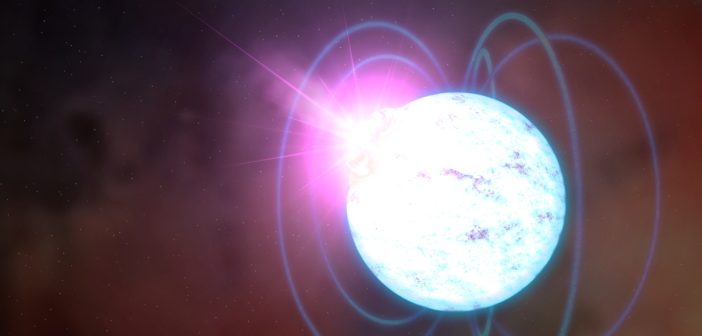Recent evidence points to highly magnetized neutron stars as the culprits that produce fast radio bursts — brief and energetic flashes of radio emission that we’ve spotted coming from distant galaxies. But do galaxy demographics support this picture?

Artist’s impression of observatories finding and localizing a fast radio burst offset from its host galaxy’s center. [CSIRO/Andrew Howells]
An Origin Mystery
In the past decade, we’ve found around a hundred unexplained, millisecond bursts of radio light that (mostly) originate from far beyond our galaxy. We’ve developed dozens of possible explanations for what might cause these fast radio bursts (FRBs) — like the mergers of compact objects, or phenomena associated with evolved or evolving stars, or even the weird physics of cosmic strings. Still, these all remain unverified theories.
When we successfully identified the host galaxy for an FRB for the first time in 2017, we hoped that this might finally reveal the cause of these explosions. Instead, the mystery of FRBs has only deepened: the ten FRBs that have well-known localizations are hosted by galaxies with surprisingly different properties.
In September 2020, a new clue was announced: a strongly magnetized neutron star — a magnetar — in our own galaxy had been observed to emit a radio burst similar to an FRB. Was this the evidence we’d been waiting for, finally proving that magnetars are the source of FRBs?
A team of scientists led by Mohammadtaher Safarzadeh (UC Santa Cruz; Center for Astrophysics | Harvard & Smithsonian) suggests that there’s a simple way to test this scenario: by comparing the demographics of magnetar-hosting and FRB-hosting galaxies.
Exploring Demographics

Top: comparison of the cumulative distribution function of FRB host galaxies (black line) to the expected global distribution of galaxies (colored lines) for total stellar mass of galaxies. Middle: same comparison, but for galaxy star formation rate. Bottom: Offset distribution of FRBs (black line) to expected distribution of magnetars in galaxies (red line). [Adapted from Safarzadeh et al. 2020]
With this in mind, Safarzadeh and collaborators first explore the distributions of stellar mass and star formation rates for the ten localized FRB host galaxies, to see whether FRBs are preferentially hosted in galaxies that are likely to contain magnetars. As an additional check, the authors then examine the offset of the FRBs from the centers of their host galaxies, to test whether FRB locations track the star formation rate profile within the galaxies.
Magnetars or Not?
The result? The authors find that there’s a clear inconsistency between the star formation rates of expected magnetar hosts and the star formation rates for observed FRB hosts — strongly indicating that not all FRBs are caused by magnetars. On the other hand, the offsets of FRBs from their galaxy centers are not inconsistent with the predicted locations of magnetar birth sites.
So are FRBs caused by magnetars or not? The results are still inconclusive, but we’re just getting started — our sample of FRBs is growing rapidly, and we’re soon likely to have a much larger collection of localized FRBs with which we can better explore the properties of their hosts. Keep an eye out for more developments on the FRB front!
Citation
“Confronting the Magnetar Interpretation of Fast Radio Bursts through Their Host Galaxy Demographics,” Mohammadtaher Safarzadeh et al 2020 ApJL 905 L30. doi:10.3847/2041-8213/abd03e
